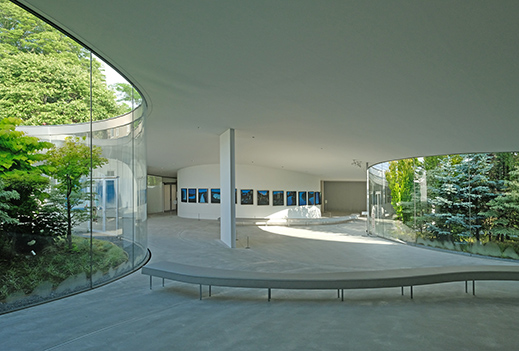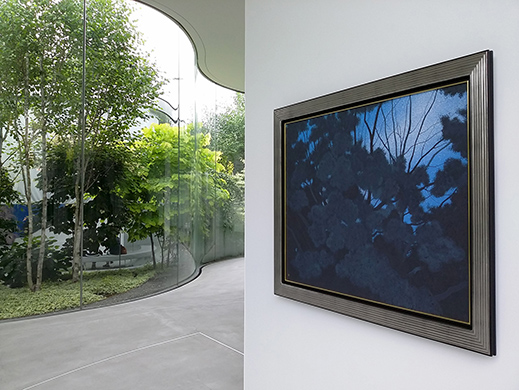 |
Focus features two in-depth reviews each month of fine art, architecture and design exhibitions and events at art museums, galleries and alternative spaces around Japan. The contributors are non-Japanese residents of Japan. |
|
|
 |
 |
 |
Open and Luminous at Hiroshi Senju Museum Karuizawa
Susan Rogers Chikuba |
 |
Boundaries between inside and out drop away in the main gallery, where shifting views from four glass-enclosed gardens flow across intersecting planes of white and Senju's paintings, too, draw you into nature. On the floor, leafy shadows play. Photo by Jeff Amas |
Part of me resists publishing a review of Hiroshi Senju Museum Karuizawa and its semiannual exhibition, as it's much better to arrive with little idea of what to expect. The 2017 autumn and winter collection of works by Senju, a minimalist nihonga painter who takes on expansive themes like water and sky, runs through Christmas day. If you haven't yet experienced this tour de force of art, architecture and nature, stop reading now and just make plans to go.
UV filter glass and reflective solar screens in the windows help to protect the artworks as they cast silhouettes of the landscaped surroundings onto the exterior and interior walls. The works in the photo at right are Ballad of Waves (1998) and Fuji Choyo (Morning Sun and Fuji; 2000). Photos by Jeff Amas |
Karuizawa's many charms notwithstanding, you'd do well to allow the better part of a day for the museum. Not because its holdings are so vast or the grounds so large but rather because the constantly changing conditions of light, wind, and sky outside will directly shape your experience inside. With less than 1,500 square meters of floor space in the main exhibition hall the venue is in fact relatively compact, although its meandering routes and airy, transparent design by Ryue Nishizawa leave the opposite impression. This architectural magic alone is worth a visit. Indeed, on the day I was there, a busload of aspiring architects sprawled on the floor and benches, sketching intently.
 |
|
Preserving the original contours of the site, the floor of the main gallery slopes markedly downward, drawing visitors deeper as they move through the exhibits. Unobtrusive steel strips sunk flush into the floor are the only suggestion of a route. Organically shaped benches, also of Nishizawa's design, complement the free-flowing lines. Photo by Jeff Amas |
The natural grade of the museum site drops more than three meters from front to back. Rather than leveling off the ground or staggering floor heights as would typically be done, Nishizawa instead had the foundation itself follow the sloping terrain. It's startling at first to realize the entire building is set at a tilt, but as you move literally and figuratively deeper into Senju's world, this nod to sense of place makes for a very satisfying union of physical and emotional movement.
Each season, every kind of weather, and even the time of day afford different contexts for viewing the art. Imagine how lovely this view would be after a fresh fall of snow. Photo by Jeff Amas |
Such alchemic merging of outer and inner, of method or form with content, is something Senju aspires to achieve in his art. He writes of the difficulty he had when, decades ago, he attempted to paint his first waterfall. He had been following a herd of wild deer in a remote area of Hawaii when he glimpsed a buck that soon disappeared into the trees. Later, when trying to recreate the scene, he decided to invoke the image of falling water as a means of suggesting the animal's power and sacredness. After several failed attempts at intentionally drawing a waterfall he poured pigment from the top of the canvas and let it stream down. There on the paper was the scene he had envisioned. In that moment when medium and message became one, he realized that it was cascades, not deer, that he had been led there to paint. They have since become one of his favorite muses and most celebrated themes.
 |
|
The structure merges with the landscape, revealing inner gardens connected by fluid lines. The series When the Stardust Falls (1994) is partially visible in the background. Photo by Jeff Amas |
In the same way that deer, long considered divine messengers in Japan, had led Senju to a personal discovery, his meditative museum, too, invites us to come home to ourselves in a place filled with nature. Senju's brief for Nishizawa was to build an open, light-filled, contemplative venue, but one that didn't carry the slightest impression of being architecture. Nishizawa's response was a space that feels, quite fantastically, at once like an open park and a private (if magnificent) living room. "I wanted people to have the sensation of walking through a forest and encountering, one by one, the world of Senju's art along the way," he explains. At the farthest end of the gallery is When the Stardust Falls, a 16-part series that follows the trail of a young deer as it journeys from its home in the forest along a river to a distant city and back. It has been published as a picture book without text, in keeping with Senju's wish that people "create their own narrative, discover their own mythology and communicate it to others."
 |
|
Senju began using fluorescent pigments after 2005. When viewed under long-wave ultraviolet light, they yield an intense blue, as seen here in Dayfall/Nightfall (2007). Photo by Jeff Amas |
Though Senju uses deeply hued traditional nihonga pigments made of ground stone, shell and coral, and paints on textured washi paper for many of his works, he also experiments with paints and techniques that lie outside nihonga conventions. Dayfall/Nightfall and Iguaçu are two fluorescent installations housed in a separate, womblike gallery. Shown under a two-minute loop of black lights, they evoke the changing moods of light as it plays on water in the course of a day. Senju has said that unlike mineral pigments, oils or acrylics, phosphorescent paints enable him to explore the mysterious, mystical quality of night and that part of us which resides in it, thereby expressing greater subtleties of the mind.
In the foreground are two works from the Waterfall series. Photo by Jeff Amas |
In all, some 50 works are on display. The Fall, a colossal mural for which Senju received Honorable Mention at La Biennale di Venezia in 1995, occupies its own separate gallery and for this show has been united via special imaging effects with six other works, four of which are held in other collections. Together the seven are presented in a movie depicting the progression of all four seasons, thus rounding out the annual exhibition cycle before the museum closes for the winter through February. (Fans of the talented Senju siblings should note that the score, "Return to Forest," was composed by brother Akira and features sister Mariko on violin.)
 |
|
Senju notes that observing and experiencing nature are a must for him when pursuing a new subject. Forest "M" (2006) is named for the trees of Meiji Shrine that were its inspiration. When I returned to view this in the late afternoon, sunbeams fell across the work, crisscrossing its nighttime light of moon and stars and giving still more depth to the trees. Photo by Jeff Amas |
Some think of museums as fallback options for wet-weather days. At this venue, if it's raining or snowing or sleeting, all the better -- you can take in nature's show even as you stay dry and enjoy the art along with it. I arrived in the morning and spent a few hours viewing the exhibits before returning, on a whim, in the afternoon an hour before closing time. Everything had changed. Where a still, sunshiny mood had prevailed in the morning and noon hours, punctuated occasionally by the soft chatter of gallerygoers and the laughter of those architecture students, later in the day as the sun dipped and the wind rose every surface had seemingly come alive. Low-angled shafts of light and the shadows of breeze-blown trees bounced around on the floors, the ceiling, the artworks. The building itself felt in motion, in concert with nature, Senju's greatest muse. For a taste of the timeless and a peaceful meditation on eternal flux, this is a place to return to again and again.
All images are by permission of Hiroshi Senju Museum Karuizawa.
|
 |
 |
Susan Rogers Chikuba
Susan Rogers Chikuba, a Tokyo-based writer, editor and translator, has been following popular culture, architecture and design in Japan for three decades. She covers the country's travel, art, literary and culinary scenes for domestic and international publications. |
|
 |
|